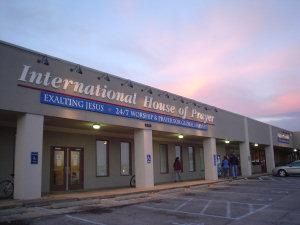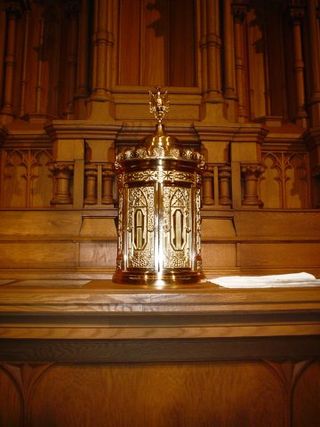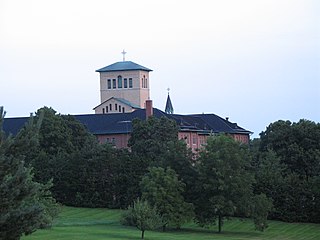
Perpetual prayer (Latin: laus perennis) is the Christian practice of continuous prayer carried out by a group.

Perpetual prayer (Latin: laus perennis) is the Christian practice of continuous prayer carried out by a group.
The practice of perpetual prayer was inaugurated by the archimandrite Alexander (died about 430), the founder of the monastic Acoemetae or "vigil-keepers".
Laus perennis was imported to Western Europe at St. Maurice's Abbey in Agaunum, where it was carried on, day and night, by several choirs, or turmae, who succeeded each other in the recitation of the divine office, so that prayer went on without cessation. Called the Akoimetoi ("Sleepless Ones"), these monks prayed "a monastic round of twenty-four offices to fill every hour." [1] The inauguration of laus perennis at Agaunum c. 515 was the occasion of a solemn ceremony, and of a sermon by St. Avitus which survives. [2] The "custom of Agaunum", as it came to be called, spread over Gaul, to Lyons, Châlons, the Abbey of Saint Denis, to Luxeuil, Saint-Germain at Paris, Saint Medard at Soissons, to Saint-Riquier, and was taken up by the monks of Remiremont Abbey and Laon Abbey, though the Abbey of Agaunum had ceased to practice it from the beginning of the ninth century. [3]
The various Roman Catholic orders of nuns dedicated to the perpetual adoration of the Blessed Sacrament may be seen as a modern variation on this theme, because in addition to the usual complete daily liturgical celebration of the Eucharist and Divine Office, these monastic communities also observe a perpetual adoration of the Blessed Sacrament, which usually involves having at least two members of the monastic community always being present in prayerful, silent contemplation of the Blessed Sacrament (i.e., a consecrated Host) exposed to view in a monstrance on the altar of the principal chapel. These monastic communities may themselves see their particular vocation as a part of a larger, more traditional monastic order, such as the Benedictine Sisters of Perpetual Adoration in Clyde, Missouri.

The first known Protestant continuous prayer was the "Hourly Intercession" of the Moravian Brethren in Herrnhut, Saxony. Beginning in 1727, the prayer continued 24 hours a day every day uninterrupted for over 100 years. The Moravian Unity began this continuous prayer vigil anew in 1957 as part of their 500th anniversary observance.
Today, perpetual prayer is a common practice in many churches. Often the term 24-7 prayer is used to express that the prayer continues 24 hours 7 days a week. A notable example of current day perpetual prayer is the Jerusalem House of Prayer, International House of Prayer in Kansas City as well as other prayer houses such as the Justice House of Prayer that were inspired by this ministry. Many churches organize 24-7 prayer weeks that last for one or several weeks.
Also, many of the Cursillo, Walk to Emmaus and other similar Three Day and 4th Day Movements employ a similar laus perennis model during the actual retreats as 4th Day members who have already attended the events sign up for and maintain a continuous prayer clock throughout each retreat of each community with specific prayers for each new participant, or pilgrim.

Eucharistic adoration is a Eucharistic devotional practice primarily in Western Catholicism, but also to a lesser extent in certain Lutheran and Anglican traditions, in which the Blessed Sacrament is adored by the faithful. This practice may occur either when the Eucharist is exposed, or when it is not publicly viewable because it is reserved in a place such as a church tabernacle.
Agaunum was an outpost in Roman Switzerland, predecessor of the modern city of Saint-Maurice in the canton of Valais, southwestern Switzerland. It was used by the Roman Empire for the collection of the Quadragesima Galliarum. In Christian tradition, Agaunum is known as the place of martyrdom of the Theban Legion.

Saint Amatus, also called Amatus of Grenoble or Saint Ame or Aimee, was a Frankish Colombanian monk and hermit. Together with St. Romaric, he founded Remiremont Abbey.

Peter Julian Eymard was a French Catholic priest and founder of two religious institutes: the Congregation of the Blessed Sacrament for men and the Servants of the Blessed Sacrament for women.

In Christian liturgy, a vigil is, in origin, a religious service held during the night leading to a Sunday or other feastday. The Latin term vigilia, from which the word is derived meant a watch night, not necessarily in a military context, and generally reckoned as a fourth part of the night from sunset to sunrise. The four watches or vigils were of varying length in line with the seasonal variation of the length of the night.

During the Mass of the Faithful, the second part of the Mass, the elements of bread and wine are considered to have been changed into the veritable Body and Blood of Jesus Christ. The manner in which this occurs is referred to by the term transubstantiation, a theory of St. Thomas Aquinas, in the Roman Catholic Church. Members of the Orthodox, Anglican, and Lutheran communions also believe that Jesus Christ is really and truly present in the bread and wine, but they believe that the way in which this occurs must forever remain a sacred mystery. In many Christian churches some portion of the consecrated elements is set aside and reserved after the reception of Communion and referred to as the reserved sacrament. The reserved sacrament is usually stored in a tabernacle, a locked cabinet made of precious materials and usually located on, above, or near the high altar. In Western Christianity usually only the Host, from Latin: hostia, meaning "victim", is reserved, except where wine might be kept for the sick who cannot consume a host.


Maria Rickenbach Monastery is a Benedictine monastery of Religious Sisters. It is situated in the village of Niederrickenbach in the municipality of Oberdorf in the Swiss canton of Nidwalden. It is accessible to the public only by cable car from Niederrickenbach Station on the Luzern–Stans–Engelberg railway line, although there is a private road leading up to the village from Dallenwil.

Eucharist is the name that Catholics give to the sacrament by which, according to their belief, the body and blood of Christ are present in the bread and wine that are consecrated during the Catholic eucharistic liturgy, generally known as the Mass. The definition of the Eucharist in the 1983 Code of Canon Law as the sacrament where Christ himself "is contained, offered, and received" points to the three aspects of the Eucharist according to Catholic theology: the real presence of Christ in the Eucharist, Holy Communion, and the holy sacrifice of the Mass.

Catholic devotions are particular customs, rituals, and practices of worship of God or honour of the saints which are in addition to the liturgy of the Catholic Church. The United States Conference of Catholic Bishops describes devotions as "expressions of love and fidelity that arise from the intersection of one's own faith, culture and the Gospel of Jesus Christ". Devotions are not considered part of liturgical worship, even if they are performed in a church or led by a priest, but rather they are paraliturgical. The Congregation for Divine Worship at the Vatican publishes a Directory on Popular Piety and the Liturgy.

The Abbey of Saint Maurice, Agaunum is a Swiss monastery of canons regular in Saint-Maurice, Canton of Valais, which dates from the 6th century. It is situated against a cliff in a section of the road between Geneva and the Simplon Pass. The abbey itself is a territorial abbacy and not part of any diocese. It is best known for its connection to the martyrdom of the Theban Legion, its original practice of perpetual psalmody, and a collection of art and antiquity.

The Congregation of the Blessed Sacrament, commonly known as the Sacramentinos is a Catholic Clerical Religious Congregation of Pontifical Right for men founded by St. Pierre-Julien Eymard. Its members use the nominal letters S.S.S. which is the acronym of its official name in Latin, after their names. By their life and activities, they assist the Church in her efforts to form Christian communities whose center of life is the Eucharist. They commit themselves to the implementation of this ideal in collaboration with lay men and women engaged in various ministries.
Forty Hours' Devotion, in Italian called Quarant'ore or written in one word Quarantore, is a Roman Catholic liturgical action in which continuous prayer is made for forty hours before the Blessed Sacrament in solemn exposition. It often occurs in a succession of churches, with one finishing prayers at the same time as the next takes it up.

Holy Hour is the Roman Catholic devotional tradition of spending an hour in Eucharistic adoration in the presence of the Blessed Sacrament. A plenary indulgence is granted for this practice. The practice is also observed in some Lutheran churches and some Anglican churches.
The Tabernacle Societies were lay Eucharistic Adorative associations within Roman Catholic parishes, principally in America and Australia, forming part of the Archassociation of the Eucharist under the guidance of the Association of Perpetual Adoration of the Blessed Sacrament.

The Servants of the Blessed Sacrament is a Roman Catholic contemplative, but not cloistered, congregation of sisters with a focus on Eucharistic adoration.

Mechtilde of the Blessed Sacrament, born Catherine de Bar was a French nun, the founder of the order of Benedictine Nuns of Perpetual Adoration of the Blessed Sacrament. She is recognized as the Servant of God in the Catholic Church.

The Adorers of the Sacred Heart of Jesus of Montmartre OSB is a Catholic order of Benedictine nuns, often known as Tyburn nuns. The order was founded in Paris but later moved to a new Mother House in London and established additional monasteries in nine other countries. The Nuns at the London monastery practise the Perpetual Adoration of the Blessed Sacrament and maintain a shrine dedicated to the Catholic martyrs of the English Reformation.

Silverstream Priory is a Roman Catholic monastery in Stamullen, County Meath, Ireland, founded in 2012. The monastery is an autonomous diocesan priory of the Benedictine Monks of Perpetual Adoration.
Benedictine Nuns of Perpetual Adoration of the Blessed Sacrament is an female enclosed Catholic order founded in Paris, France in 1653 by Mechtilde of the Blessed Sacrament.